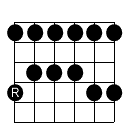The stage is set.
The fans have gathered and the band opens up with it’s first song. Quick, it’s time for a solo, but what do you play?
That’s easy. We’ll just improvise!
“To improvise means to make it up on the spot, right?”, you ask.
Yes, we’re going to make the solo up as we go along. All we need to know is what key the song is in and then we can find which scale to use.
It’s easy and I’ll show you…
Scales give us a blueprint of what notes will work and what notes will not work when it comes time to play a solo.
The first thing you have to ask yourself when you are preparing to solo is ” What key is the song in?”.
Once the key signature of the song is determined you can easily find the right scale to play.
For example, if the song is in the key of C, we’ll want to use a C major scale. If the key is in Am we’ll want to use an A minor scale.
You can even change the scale used for each chord in the song (more on this later)!
You’ll notice that there are 12 different key signatures for each scale. That doesn’t mean you have to learn the scale 12 separate times. You only need to learn the different positions of each scale in one key because you simply have to move the positions up or down the fretboard in order to change keys. If you know the notes on the bottom string you can quickly translate the scale patterns to any key signature.
The first positon of any scale is the root position. The root note is always the lowest note in the first position (except for the pentatonic major scale-more on that in a moment). In diagram bellow you can see a visual representation of the pentatonic minor scale in 1st position. The root note of the scale is marked by an “R”.
Major Pentatonic
The pentatonic major is the only scale with it’s root note in a place other than the lowest note. It’s the second note on the bottom string as illustrated below:

| Fret | 1 | 2 | 3 | 4 | 5 | 6 | 7 | 8 | 9 | 10 | 11 | 12 |
| Chord | – | – | (open) G | G#/Ab | A | A#/Bb | B | C | C#/Db | D | D#/Eb | E |
To play in different key signatures we move the patterns around.
Minor Pentatonic

Since the pattern is the same for any key we must simply match the root note to the note on the 6th string that matches the name of the key.
| Fret | 1 | 2 | 3 | 4 | 5 | 6 | 7 | 8 | 9 | 10 | 11 | 12 |
| Key | F | F#/Gb | G | G#/Ab | A | A#/Bb | B | C | C#/Db | D | D#/Eb | E |